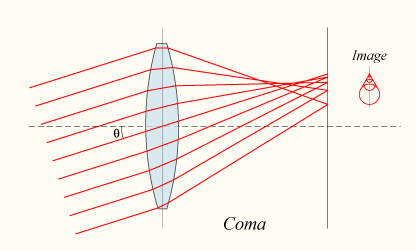孫子兵法
《兵勢》
孫子曰:凡治眾如治寡,分數是也。鬥眾如鬥寡,形名是也。三軍之眾,可使必受敵而無敗者,奇正是也。兵之所加,如以碬投卵者 ,虛實是也。
凡戰者,以正合,以奇勝。故善出奇者,無窮如天地,不竭如江河 ,終而復始,日月是也;死而復生,四時是也。聲不過五,五聲之變,不可勝聽也。色不過五,五色之變,不可勝觀也。味不過五,五味之變,不可勝嘗也。戰勢不過奇正,奇正之變,不可勝窮也。奇正相生,如循環之無端,孰能窮之哉!
激水之疾,至于漂石者,勢也。鷙鳥之擊,至于毀折者,節也。是故善戰者,其勢險,其節短,勢如張弩,節如機發。
紛紛紜紜,鬥亂,而不可亂也。渾渾沌沌,形圓,而不可敗也。亂生于治,怯生于勇,弱生于強。治亂,數也。勇怯,勢也。強弱,形也。故善動敵者,形之,敵必從之;予之,敵必取之;以利動之 ,以實待之。
故善戰者,求之于勢,不責于人,故能擇人任勢;任勢者,其戰人也,如轉木石,木石之性,安則靜,危則動,方則止,圓則行。故善戰人之勢,如轉圓石于千仞之山者,勢也。
就幾何光學理論來說,透鏡、材質、虛空之矩陣的組合亦無窮矣!不知能否對治各種
像差
像差(英語:Optical aberration)是光學中,實際像與根據單透鏡理論確定的理想像的偏離。這些偏離是折射作用造成的。像差是由透鏡對色光的不同彎曲能力所致,並造成帶有色暈的像。單色像差與是與色無關的像差,包括使畸變、像場彎曲等變形像差和面像、形像、散光等使像模糊的像差。像差在照相機、望遠鏡和其他光學儀器中可以通過透鏡的組合減小到最低限度。面鏡也有與透鏡一樣的單色像差,沒有像差。
初階像差分為五種:球面像差、 彗形像差、 散光、 場曲、 畸變。
Optical aberration
An optical aberration is a departure of the performance of an optical system from the predictions of paraxial optics.[1] In an imaging system, it occurs when light from one point of an object does not converge into (or does not diverge from) a single point after transmission through the system. Aberrations occur because the simple paraxial theory is not a completely accurate model of the effect of an optical system on light (due to the wave nature of light), rather than due to flaws in the optical elements.[2]
Aberration leads to blurring of the image produced by an image-forming optical system. Makers of optical instruments need to correct optical systems to compensate for aberration.
The articles on reflection, refraction and caustics discuss the general features of reflected and refracted rays.
的呢?且先知目前科技總結乎!!

Laser guide stars are used to eliminate optical aberrations.[8]
Practical elimination of aberrations
The classical imaging problem is to reproduce perfectly a finite plane (the object) onto another plane (the image) through a finite aperture. It is impossible to do so perfectly for more than one such pairs of planes (this was proven with increasing generality by Maxwell in 1858, by Bruns in 1895, and by Carathéodory in 1926, see summary in Walther, A., J. Opt. Soc. Am. A 6, 415–422 (1989)). For a single pair of planes (e.g. for a single focus setting of an objective), however, the problem can in principle be solved perfectly. Examples of such a theoretically perfect system include the Luneburg lens and the Maxwell fish-eye.
Practical methods solve this problem with an accuracy which mostly suffices for the special purpose of each species of instrument. The problem of finding a system which reproduces a given object upon a given plane with given magnification (insofar as aberrations must be taken into account) could be dealt with by means of the approximation theory; in most cases, however, the analytical difficulties were too great for older calculation methods but may be ameliorated by application of modern computer systems. Solutions, however, have been obtained in special cases (see A. Konig in M. von Rohr’s Die Bilderzeugung, p. 373; K. Schwarzschild, Göttingen. Akad. Abhandl., 1905, 4, Nos. 2 and 3). At the present time constructors almost always employ the inverse method: they compose a system from certain, often quite personal experiences, and test, by the trigonometrical calculation of the paths of several rays, whether the system gives the desired reproduction (examples are given in A. Gleichen, Lehrbuch der geometrischen Optik, Leipzig and Berlin, 1902). The radii, thicknesses and distances are continually altered until the errors of the image become sufficiently small. By this method only certain errors of reproduction are investigated, especially individual members, or all, of those named above. The analytical approximation theory is often employed provisionally, since its accuracy does not generally suffice.
In order to render spherical aberration and the deviation from the sine condition small throughout the whole aperture, there is given to a ray with a finite angle of aperture u* (width infinitely distant objects: with a finite height of incidence h*) the same distance of intersection, and the same sine ratio as to one neighboring the axis (u* or h* may not be much smaller than the largest aperture U or H to be used in the system). The rays with an angle of aperture smaller than u* would not have the same distance of intersection and the same sine ratio; these deviations are called zones, and the constructor endeavors to reduce these to a minimum. The same holds for the errors depending upon the angle of the field of view, w: astigmatism, curvature of field and distortion are eliminated for a definite value, w*, zones of astigmatism, curvature of field and distortion, attend smaller values of w. The practical optician names such systems: corrected for the angle of aperture u* (the height of incidence h*) or the angle of field of view w*. Spherical aberration and changes of the sine ratios are often represented graphically as functions of the aperture, in the same way as the deviations of two astigmatic image surfaces of the image plane of the axis point are represented as functions of the angles of the field of view.
The final form of a practical system consequently rests on compromise; enlargement of the aperture results in a diminution of the available field of view, and vice versa. But the larger aperture will give the larger resolution. The following may be regarded as typical:
- (1) Largest aperture; necessary corrections are — for the axis point, and sine condition; errors of the field of view are almost disregarded; example — high-power microscope objectives.
- (2) Wide angle lens; necessary corrections are — for astigmatism, curvature of field and distortion; errors of the aperture only slightly regarded; examples — photographic widest angle objectives and oculars.
- Between these extreme examples stands the normal lens: this is corrected more with regard to aperture; objectives for groups more with regard to the field of view.
- (3) Long focus lenses have small fields of view and aberrations on axis are very important. Therefore zones will be kept as small as possible and design should emphasize simplicity. Because of this these lenses are the best for analytical computation.
然後了此處摘要之偏差名義︰
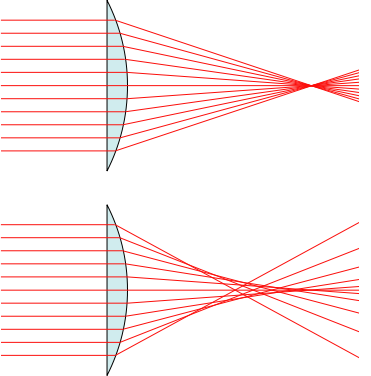
On top is a depiction of a perfect lens without spherical aberration: all incoming rays are focused in the focal point.
The bottom example depicts a real lens with spherical surfaces, which produces spherical aberration: The different rays do not meet after the lens in one focal point. The further the rays are from the optical axis, the closer to the lens they intersect the optical axis (positive spherical aberration).
(Drawing is exaggerated.)
Coma of a single lens
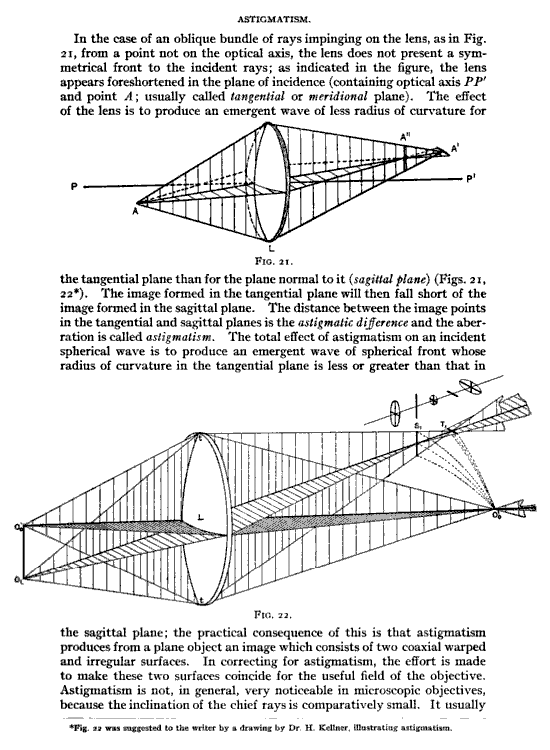
Page explaining and illustrating astigmatism[2]
【佩茲瓦爾像場彎曲】 Petzval field curvature
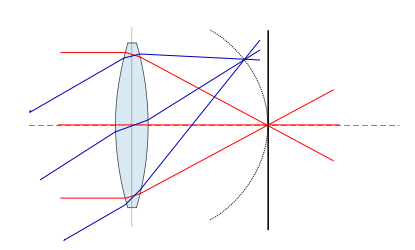
Field curvature: the image “plane” (the arc) deviates from a flat surface (the vertical line).
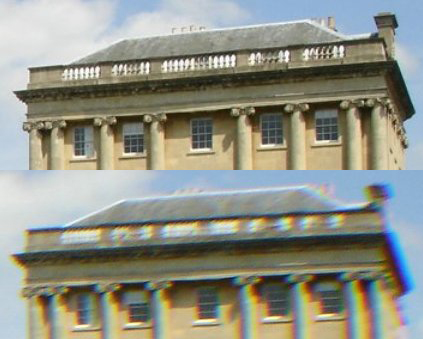
Photographic example showing high quality lens (top) compared to lower quality model exhibiting lateral chromatic aberration (seen as a blur and a rainbow edge in areas of contrast.)
【鏡頭眩光】 Lens flare

Lens flare on Borobudur stairs to enhance the sense of ascending
也可思複雜光學系統之原由吧??將能分解閱讀器物耶!!??
